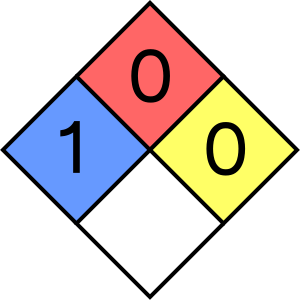POTASSIUM PHOSPHATE MONOBASIC
Basic information
- Chemical formula(s): \({\rm KH_2PO_4}\)
- Other names: Potassium dihydrogen phosphate, monopotassium phosphate, MKP, KDP
- CAS number: 7778-77-0
- EC number: 231-913-4
- Molecular weight: 136.1 g/mol
- International Chemical Safety Card (ICSC): 1608
- Flammability: no (not combustible)
- Description: Colorless crystals or white crystalline powder. Highly soluble in water (22 g/100ml). Solution is weakly acidic. Used as fertilizer, food additive, and buffer component.
NFPA 704 (fire diamond)

- Health (blue): 1 - poses no health hazard, requires no precautions, and would offer no hazard beyond that of ordinary combustible materials.
- Flammability (red): 0 - will not burn under typical fire conditions.
- Instability–reactivity (yellow): 0 - normally stable, even under fire exposure conditions, and is not reactive with water.
- Special notice (white): -
Hazard statements
Potassium phosphate monobasic is not classified as hazardous under GHS regulations. However, it may cause mild irritation:
| Code | Phrase |
|---|---|
| H315 | Causes skin irritation |
| H319 | Causes serious eye irritation |
Precautionary statements
Despite not being classified as hazardous, the following precautionary measures apply for handling crystalline powders:
| Code | Phrase |
|---|---|
| P261 | avoid breathing dust/fume/gas/mist/vapours/spray |
| P264 | wash hands thoroughly after handling |
| P280 | wear protective gloves/protective clothing/eye protection/face protection |
| P305+P351+P338 | IF IN EYES: rinse cautiously with water for several minutes, remove contact lenses if present and easy to do, continue rinsing |
| P321 | Specific treatment (see … on this label). |
| P332+P313 | IF SKIN IRRITATION OCCURS: Get medical advice/attention. |
| P337+P313 | IF EYE IRRITATION PERSISTS: Get medical advice/attention. |
Protective measures
Gloves
For routine handling of potassium phosphate powder:
- Any standard laboratory gloves: very good - potassium phosphate is minimally irritating.
- Nitrile: very good - prevents contamination and provides good chemical resistance.
- Natural latex or rubber: very good - adequate for handling salts.
- PVC: good - suitable for handling non-hazardous salts.
- Vinyl: good - adequate for food-grade applications.
Safety goggles
- Standard safety glasses recommended when handling powder to prevent eye irritation.
- Corrective glasses are not considered safety goggles.
- Eye protection particularly important as powder may cause irritation.
Clothing
- Standard laboratory clothing is sufficient.
- Long sleeves recommended when handling large quantities to minimize skin contact with dust.
- Closed-toe shoes required as standard laboratory safety.
- Remove contaminated clothing and wash before reuse.
Respiratory protection
- Ensure adequate ventilation when handling large quantities.
- Use dust mask when working with fine powder in poorly ventilated areas.
- Harmful airborne particles can accumulate quickly when powder is dispersed.
- Minimize dust generation during handling.
Spill management
- Sweep up material carefully to minimize dust generation.
- Use vacuum with appropriate filtration if available.
- Avoid creating dust clouds during cleanup.
- Collect in appropriate container - can be disposed as non-hazardous waste.
- Clean area with water to remove residual powder.
- Weakly acidic in solution - neutralize large spills if necessary.
- No special disposal requirements - non-hazardous material.
Special warnings
- Decomposes on heating - produces toxic and irritating phosphorus oxide fumes.
- Weakly acidic - aqueous solutions have pH around 4.2-4.7.
- May cause irritation - to eyes, skin, and respiratory tract.
- Hygroscopic - absorbs moisture from air, store in tightly closed containers.
- Store in cool, dry place away from strong bases.
- Food additive - generally recognized as safe (GRAS) for use in foods.
- Buffer component - commonly used with disodium phosphate for pH control.
- Fertilizer use - source of potassium and phosphorus for plants.
- Incompatible with strong bases - may react to form heat.
- Symptoms of exposure: cough, redness, pain (eyes/skin), abdominal pain, vomiting, diarrhea if ingested in large amounts.